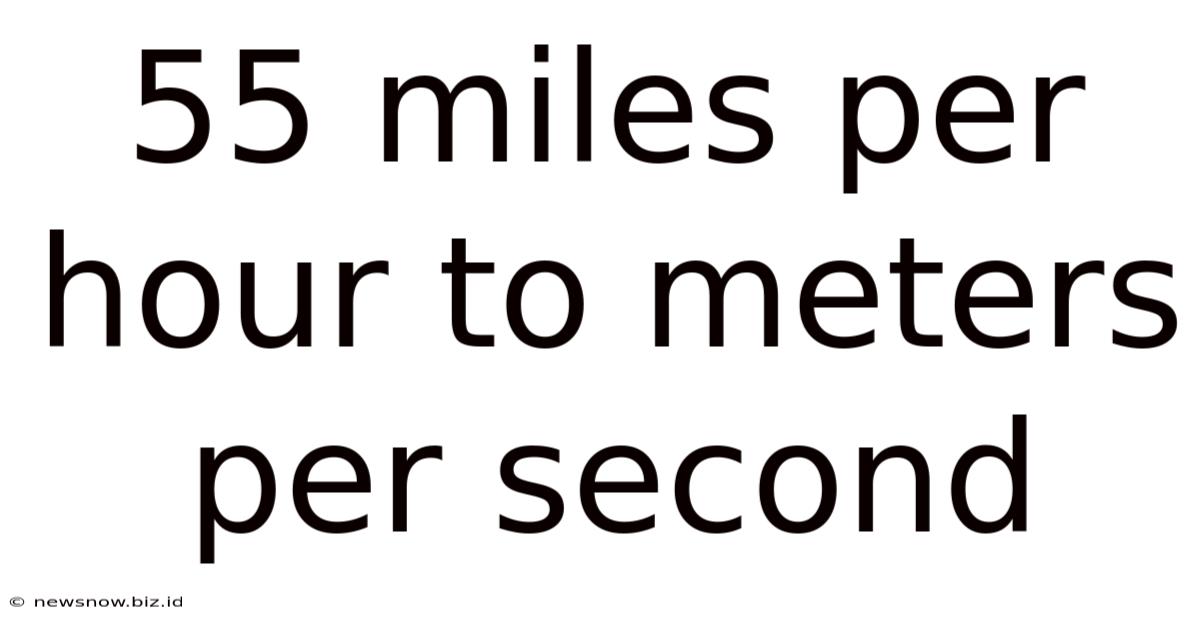55 Miles Per Hour To Meters Per Second
New Snow
May 10, 2025 · 5 min read

Table of Contents
55 Miles Per Hour to Meters Per Second: A Comprehensive Guide to Unit Conversion
The conversion of units is a fundamental aspect of numerous scientific, engineering, and everyday applications. Understanding how to effectively convert between different units is crucial for accurate calculations and clear communication. This comprehensive guide will delve into the process of converting 55 miles per hour (mph) to meters per second (m/s), exploring the underlying principles, offering multiple calculation methods, and highlighting the importance of unit consistency in various fields.
Understanding the Units Involved
Before embarking on the conversion, let's clarify the units involved:
-
Miles per hour (mph): A unit of speed expressing the distance traveled in miles within one hour. It's a commonly used unit in the United States and some other countries.
-
Meters per second (m/s): A unit of speed expressing the distance traveled in meters within one second. It's the standard unit of speed in the International System of Units (SI), the most widely used system globally.
The conversion necessitates understanding the relationships between miles and meters, and between hours and seconds.
Method 1: Step-by-Step Conversion
This method breaks down the conversion into a series of sequential steps, making the process easier to understand, particularly for those less familiar with unit conversions.
Step 1: Converting Miles to Meters
One mile is approximately equal to 1609.34 meters. Therefore, to convert 55 miles to meters, we multiply:
55 miles * 1609.34 meters/mile = 88513.7 meters
Step 2: Converting Hours to Seconds
One hour contains 60 minutes, and each minute contains 60 seconds. Therefore, one hour equals 3600 seconds (60 minutes/hour * 60 seconds/minute = 3600 seconds/hour).
Step 3: Calculating Meters per Second
Now, we have 88513.7 meters traveled in 3600 seconds. To find the speed in meters per second, we divide the distance (in meters) by the time (in seconds):
88513.7 meters / 3600 seconds ≈ 24.587 m/s
Therefore, 55 mph is approximately equal to 24.587 m/s.
Method 2: Using a Single Conversion Factor
A more concise approach involves combining the conversion factors for miles to meters and hours to seconds into a single conversion factor.
The conversion factor is derived as follows:
(1609.34 meters/mile) / (3600 seconds/hour) ≈ 0.44704 meters/(second*mile/hour)
Multiplying 55 mph by this conversion factor directly yields the result:
55 mph * 0.44704 m/(s*mph) ≈ 24.587 m/s
This method streamlines the process, providing a quicker route to the final answer.
Method 3: Dimensional Analysis
Dimensional analysis is a powerful technique for ensuring the correctness of unit conversions. It involves tracking the units throughout the calculation, ensuring they cancel out appropriately to yield the desired unit.
Let's demonstrate dimensional analysis for this conversion:
55 miles/hour * (1609.34 meters/1 mile) * (1 hour/3600 seconds)
Notice how the "miles" and "hours" units cancel out, leaving only "meters" and "seconds," resulting in the correct unit of m/s:
55 * 1609.34 / 3600 ≈ 24.587 m/s
Dimensional analysis serves as a valuable check to prevent errors in complex conversions.
Significance of Accurate Unit Conversion
Precise unit conversions are vital in various disciplines:
Engineering and Physics:
Incorrect unit conversions can lead to catastrophic errors in engineering designs and physical calculations. Imagine a bridge collapsing because of a miscalculation stemming from an incorrect unit conversion. The consequences are severe and highlight the absolute necessity of accuracy.
Aviation and Aerospace:
Aviation relies heavily on precise measurements and calculations. Errors in converting units could have fatal consequences. Accurate conversions are essential for navigation, flight planning, and ensuring the safe operation of aircraft.
Healthcare:
In medicine, accurate dosing and measurements are paramount. Incorrect conversions could lead to medication errors with potentially life-threatening consequences.
Everyday Applications:
Even in everyday life, understanding unit conversions is important for tasks ranging from cooking (converting recipes from imperial to metric units) to traveling (understanding speed limits).
Common Mistakes to Avoid
Several common errors can occur during unit conversions:
-
Incorrect Conversion Factors: Using inaccurate conversion factors is a primary source of errors. Ensure you utilize the correct values for each conversion.
-
Unit Cancellation Issues: Failing to correctly cancel out units during dimensional analysis can lead to incorrect results.
-
Significant Figures: Pay attention to the number of significant figures in your calculations to maintain accuracy. Rounding errors can accumulate and affect the final result.
-
Mixing Units: Avoid mixing units within a single calculation. Use consistent units throughout the entire process.
Beyond the Conversion: Applications of Speed and Velocity
Understanding the conversion from mph to m/s provides a foundation for tackling more complex problems involving speed and velocity. These concepts are fundamental in:
-
Kinematics: The study of motion, exploring concepts like acceleration, displacement, and velocity.
-
Dynamics: The study of forces and their effects on motion.
-
Fluid Mechanics: Analyzing the movement of fluids, incorporating concepts of speed and flow rate.
-
Traffic Engineering: Designing and managing road networks, optimizing traffic flow, and improving safety.
Conclusion
Converting 55 mph to meters per second, while seemingly simple, highlights the importance of accurate unit conversions across various fields. The methods presented – step-by-step conversion, using a single conversion factor, and dimensional analysis – offer diverse approaches to ensure accurate results. Mastering unit conversions is crucial for anyone working with quantitative data, ensuring accuracy, safety, and efficient problem-solving. By understanding the principles and avoiding common pitfalls, one can confidently tackle unit conversions and their applications in numerous contexts. Remember to always double-check your work and utilize the appropriate number of significant figures to maintain the integrity of your calculations.
Latest Posts
Related Post
Thank you for visiting our website which covers about 55 Miles Per Hour To Meters Per Second . We hope the information provided has been useful to you. Feel free to contact us if you have any questions or need further assistance. See you next time and don't miss to bookmark.